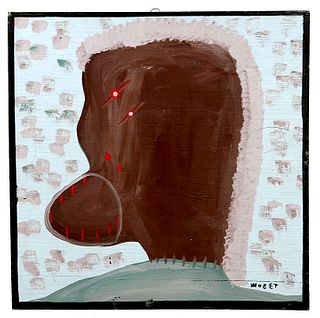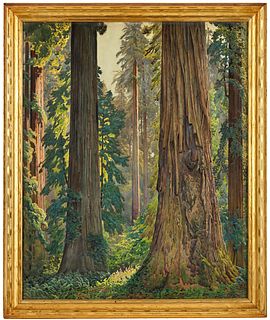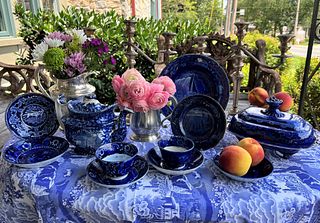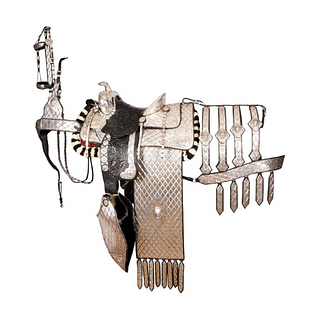A Roadshow Trump
Bought from an antiques dealer several years previously, the present owners of this painting wanted to know more about their dog. They took him along to a BBC Antiques Roadshow in July 2014 where it was instantly recognized as a copy of the dog in Hogarth’s “Manifesto” self-portrait painted in 1745.
But who reproduced it and when was it painted? A contemporary? Or by someone later? Or perhaps even by Hogarth himself? More research was needed.
In a broadcast follow-up TV program, and after discussions with several Hogarth authorities, the owners were informed that their own dog was deemed to be a good 19th century copy, possibly executed in the National Gallery where, in the 19th century, artists were given out-of-hours access to copy any chosen work on public view.
Lot 277 Fine Interiors - 29 & 30 June | Follower of William Hogarth William, Hogarth's dog 'Trump', oil on canvas, 58.5 x 46cm. Estimate £2000-3000
Painter Pug
Short, spirited and humorous, Hogarth enjoyed playing up to his public nickname, the ‘Painter Pug’. Artist and faithful dog were often seen strolling the streets of London together. From his early paintings of the 1730s, to his very last self-portrait in 1757/8, Hogarth frequently lightens or subverts the mood by introducing a pug, usually misbehaving and facing the viewer front-on. Hogarth owned at least three pugs over his lifetime, skittishly named Pug, Crab, and best-known of all, Trump. The 18th century pug-dog was larger and more leggy than today’s often wheezy toy specimen. With human or monkey-like features, it was a perfect alter-ego for a satirist. The pug’s comical presence among gentlefolk instils, or ‘trumps’, a gathering of self-importance. Even today in Northern England a ‘trump’ means ‘a blast of wind from below’. Republicans, take note!
In his 1745 "Manifesto" self-portrait Hogarth, with conscious false modesty, places his tongue-in-cheek pet before himself. The artist's look of sardonic amusement is countered by the dog's troubled stare off-stage, in seeming mockery of his master's literary aspirations – represented by the pile of tomes (Shakespeare, Milton and Swift) - upon which the inner 'trompe l'oeil' oval canvas rests. The artist repeats the pug pose seen in his earlier Strode Family group portrait, where a near-identical pug (Trump again?) upstages a family taking tea.
The Last Trump
In his final, sad-poignant self -portrait (1758) Hogarth included his final pug. But then he changed his mind. An X-ray shows the irreverent pet cocking its leg against his Master's chair. Perhaps feeling this might be regarded as a royal insult (Hogarth had only lately been appointed Serjeant Painter to the King) Hogarth seems to have lost his nerve and painted out the dog - but it remains there beneath the paint. After Hogarth's death in 1764 his dog-and-master double-portrait stayed with his widow until her death twenty-five years later in 1789. Thence it changed hands, eventually entering the Angerstein Collection which in 1824, inaugurated the newly founded National Gallery. Hogarth and his alter ego took their final walk up stream to the Tate where they may be seen today.
Meanwhile, the excellent "Roadshow Trump" looks for his next owner, featuring in Sworders' forthcoming auction of Fine Interiors on the 29 and 30 June.
_________________________________________
Don't have a Bidsquare account? Sign up here!
Be in the know about upcoming auctions and exciting post-sale results by following us on Facebook and Instagram.
- Quilts as a 2025 Design Trend: A Celebration of American Heritage and Craftsmanship
- A Celebration of Sports History and Collectibles
- Antiques and the Arts Weekly Q&A: Allis Ghim
- The Thrill of Sports Memorabilia Auctions: A Collector’s Paradise
- Demystifying Coin Condition: A Guide to the Sheldon Grading Scale
- Snoopy & Friends: A “Peanuts” Auction at Revere
- Colorful Chinese Monochromes at Millea Bros
- 12 Holiday Gifts for the “Impossible to Buy For” on Bidsquare
- Alluring Art Objects and Accessories from the Estate of Chara Schreyer
- Kimball Sterling's One-Owner Outsider and Folk Art Collection Showcases Masters of the Unconventional



 EUR
EUR CAD
CAD AUD
AUD GBP
GBP MXN
MXN HKD
HKD CNY
CNY MYR
MYR SEK
SEK SGD
SGD CHF
CHF THB
THB













